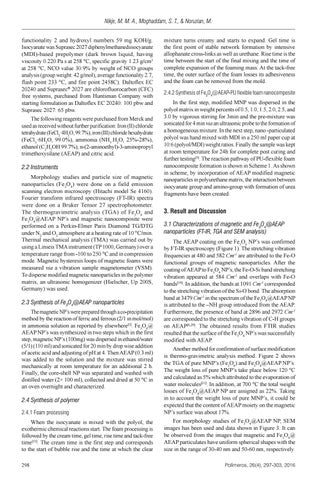Nikje, M. M. A., Moghaddam, S. T., & Noruzian, M. functionality 2 and hydroxyl numbers 59 mg KOH/g. Isocyanate was Suprasec 2027 diphenylmethanediisocyanate (MDI)-based prepolymer (dark brown liquid, having viscosity 0.220 Pa s at 258 °C, specific gravity 1.23 g/cm3 at 258 °C, NCO value 30.9% by weight of NCO groups analysis (group weight: 42 g/mol), average functionality 2.7, flash point 233 °C, and fire point 2458C). Daltoflex EC 20240 and Suprasec 2027 are chlorofluorocarbon (CFC) free systems, purchased from Huntsman Company with starting formulation as Daltoflex EC 20240: 100 pbw and Suprasec 2027: 65 pbw. The following reagents were purchased from Merck and used as received without further purification: Iron (II) chloride tetrahydrate (FeCl2·4H2O, 99.7%), iron (III) chloride hexahydrate (FeCl3·6H2O, 99.0%), ammonia (NH3.H2O, 25%-28%), ethanol (C2H5OH 99.7%), n-(2‑aminoethyl)-3-aminopropyl trimethoxysilane (AEAP) and citric acid.
2.2 Instruments Morphology studies and particle size of magnetic nanoparticles (Fe3O4) were done on a field emission scanning electron microscopy (Hitachi model Se 4160). Fourier transform infrared spectroscopy (FT-IR) spectra were done on a Bruker Tensor 27 spectrophotometer. The thermogravimetric analysis (TGA) of Fe3O4 and Fe3O4@AEAP NP’s and magnetic nanocomposite were performed on a Perkin-Elmer Paris Diamond TG/DTG under N2 and O2 atmosphere at a heating rate of 10 °C/min. Thermal mechanical analysis (TMA) was carried out by using a Linseis TMA instrument (TP 1000, Germany) over a temperature range from -100 to 250 °C and in compression mode. Magnetic hysteresis loops of magnetic foams were measured via a vibration sample magnetometer (VSM). To disperse modified magnetic nanoparticles in the polymer matrix, an ultrasonic homogenizer (Hielscher, Up 200S, Germany) was used.
2.3 Synthesis of Fe3O4@AEAP nanoparticles The magnetic NP’s were prepared through a co‑precipitation method by the reaction of ferric and ferrous (2/1 in mol/mol) in ammonia solution as reported by elsewhere[5]. Fe3O4@ AEAP NP’s was synthesized in two steps which in the first step, magnetic NP’s (100mg) was dispersed in ethanol/water (5/1) (110 ml) and sonicated for 20 min by drop wise addition of acetic acid and adjusting of pH at 4. Then AEAP (0.3 ml) was added to the solution and the mixture was stirred mechanically at room temperature for an additional 2 h. Finally, the core-shell NP was separated and washed with distilled water (2× 100 ml), collected and dried at 50 °C in an oven overnight and characterized.
mixture turns creamy and starts to expand. Gel time is the first point of stable network formation by intensive allophanate cross-links as well as urethane. Rise time is the time between the start of the final mixing and the time of complete expansion of the foaming mass. At the tack-free time, the outer surface of the foam losses its adhesiveness and the foam can be removed from the mold. 2.4.2 Synthesis of Fe3O4@AEAP-PU flexible foam nanocomposite In the first step, modified MNP was dispersed in the polyol matrix in weight percents of 0.5, 1.0, 1.5, 2.0, 2.5, and 3.0 by vigorous stirring for 3min and the pre-mixture was sonicated for 4 min via an ultrasonic probe to the formation of a homogeneous mixture. In the next step, nano ‑particulated polyol was hand mixed with MDI in a 250 ml paper cup at 10:6 (polyol/MDI) weight ratios. Finally the sample was kept at room temperature for 24h for complete post curing and further testing[5]. The reaction pathway of PU-flexible foam nanocomposite formation is shown in Scheme 1. As shown in scheme, by incorporation of AEAP modified magnetic nanoparticles in polyurethane matrix, the interaction between isocyanate group and amino‑group with formation of urea fragments have been created.
3. Result and Discussion 3.1 Characterizations of magnetic and Fe3O4@AEAP nanoparticles (FT-IR, TGA and SEM analysis) The AEAP coating on the Fe3O4 NP’s was confirmed by FT-IR spectroscopy (Figure 1). The stretching vibration frequencies at 480 and 582 Cm-1 are attributed to the Fe-O functional groups of magnetic nanoparticles. After the coating of AEAP to Fe3O4 NP’s, the Fe-O-Si band stretching vibration appeared at 584 Cm-1 and overlaps with Fe-O bands[19]. In addition, the bands at 1091 Cm-1 corresponded to the stretching vibration of the Si-O bond. The absorption band at 3479 Cm-1 in the spectrum of the Fe3O4@AEAP NP is attributed to the –NH group introduced from the AEAP. Furthermore, the presence of band at 2896 and 2972 Cm-1 are corresponded to the stretching vibration of C-H groups on AEAP[6,20]. The obtained results from FTIR studies resulted that the surface of the Fe3O4 NP’s was successfully modified with AEAP.
2.4.1 Foam processing
Another method for confirmation of surface modification is thermo-gravimetric analysis method. Figure 2 shows the TGA of pure MNP’s (Fe3O4) and Fe3O4@AEAP NP’s. The weight loss of pure MNP’s take place below 120 °C and calculated as 5% which attributed to the evaporation of water molecules[21]. In addition, at 700 °C the total weight losses of Fe3O4@AEAP NP are assigned as 22%. Taking in to account the weight loss of pure MNP’s, it could be expected that the content of AEAP moiety on the magnetic NP’s surface was about 17%.
When the isocyanate is mixed with the polyol, the exothermic chemical reactions start. The foam processing is followed by the cream time, gel time, rise time and tack‑free time[15]. The cream time is the first step and corresponds to the start of bubble rise and the time at which the clear
For morphology studies of Fe3O4@AEAP NP, SEM images has been used and data shown in Figure 3. It can be observed from the images that magnetic and Fe3O4@ AEAP particulates have uniform spherical shapes with the size in the range of 30-40 nm and 50-60 nm, respectively.
2.4 Synthesis of polymer
298
Polímeros, 26(4), 297-303, 2016
